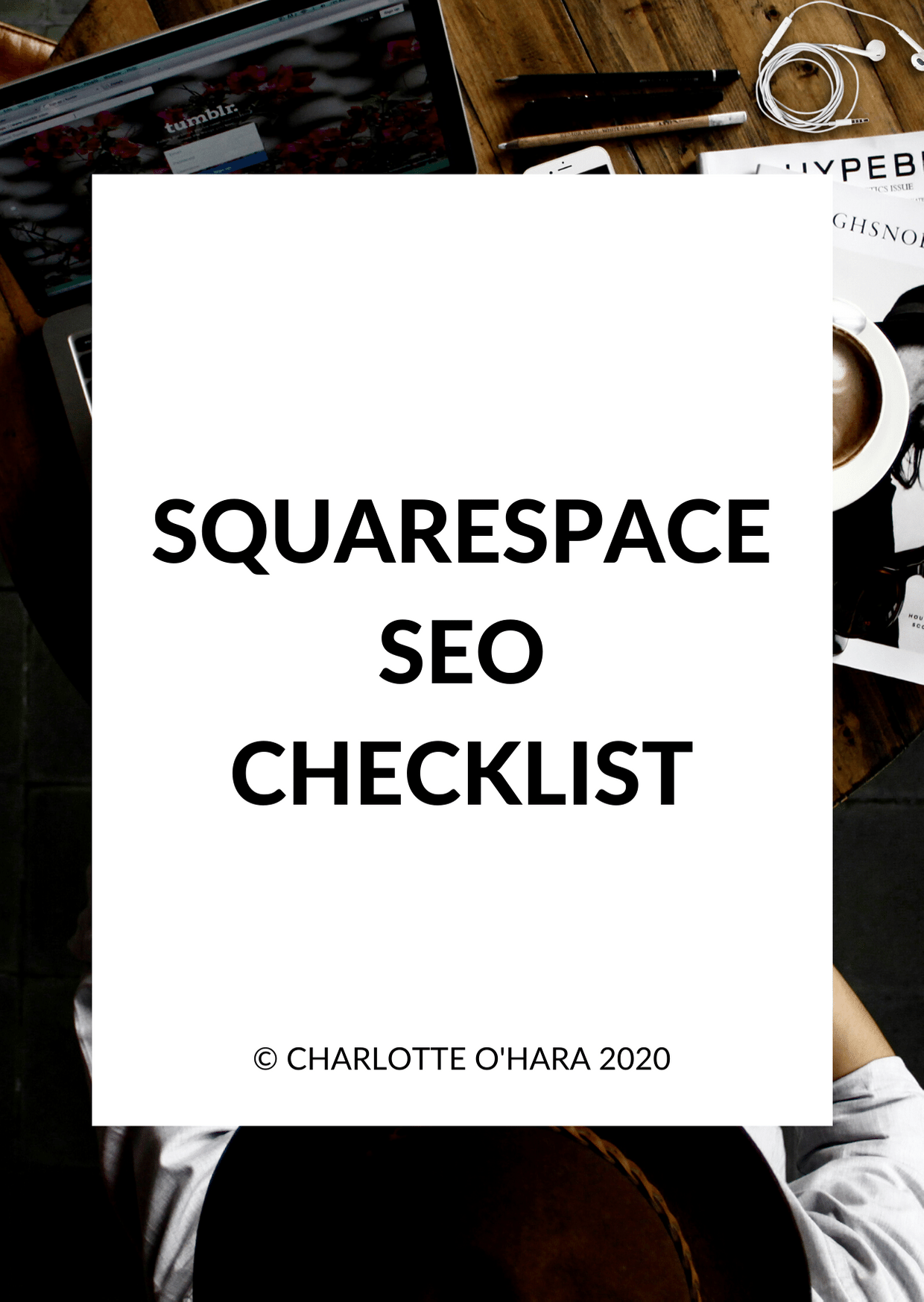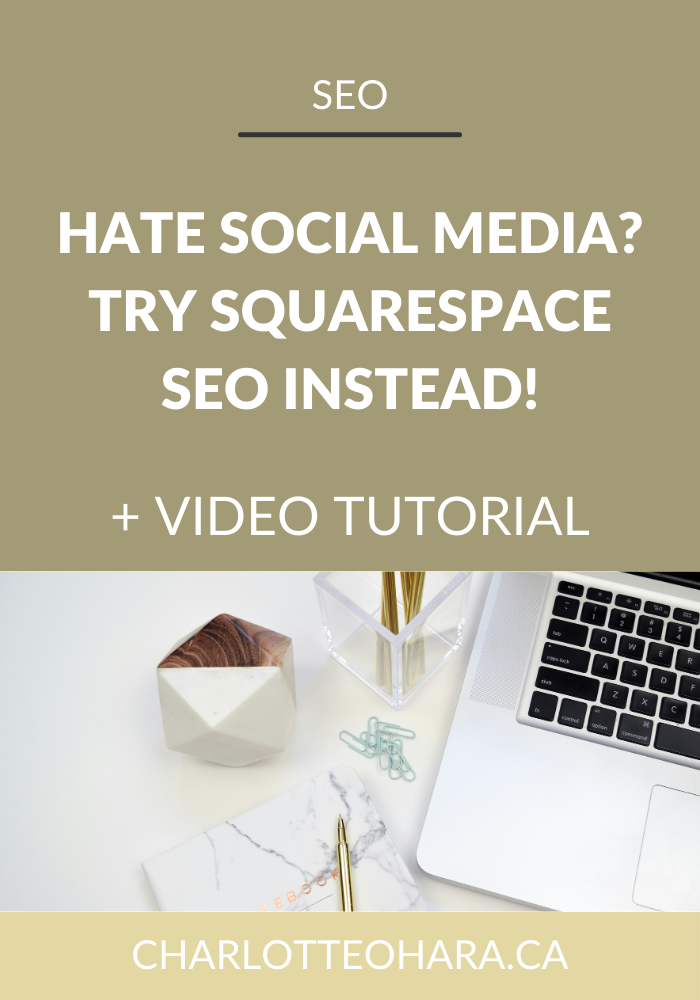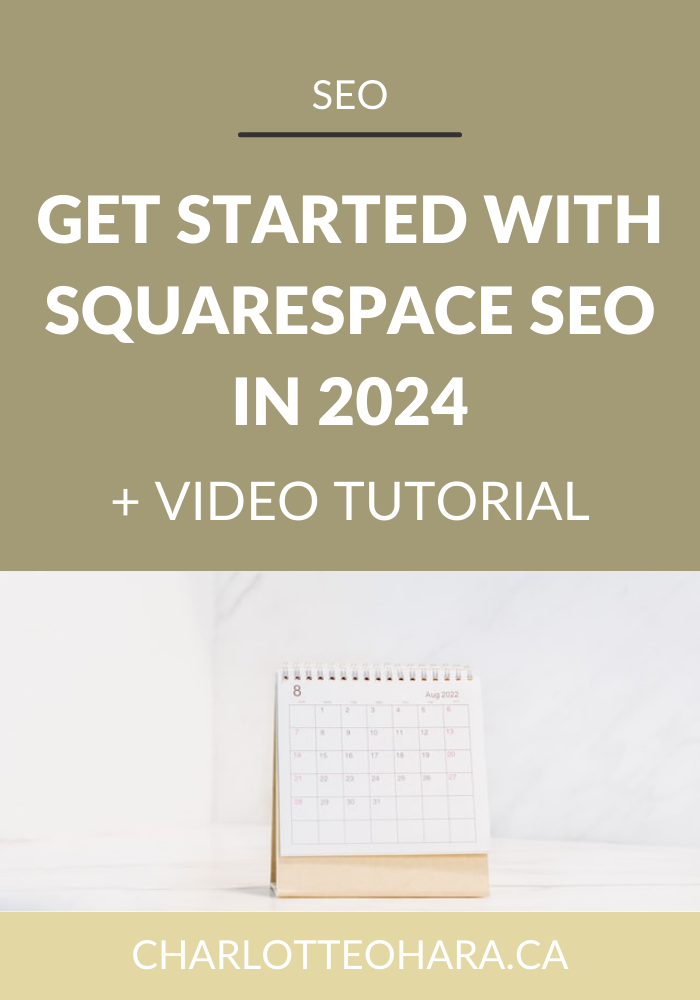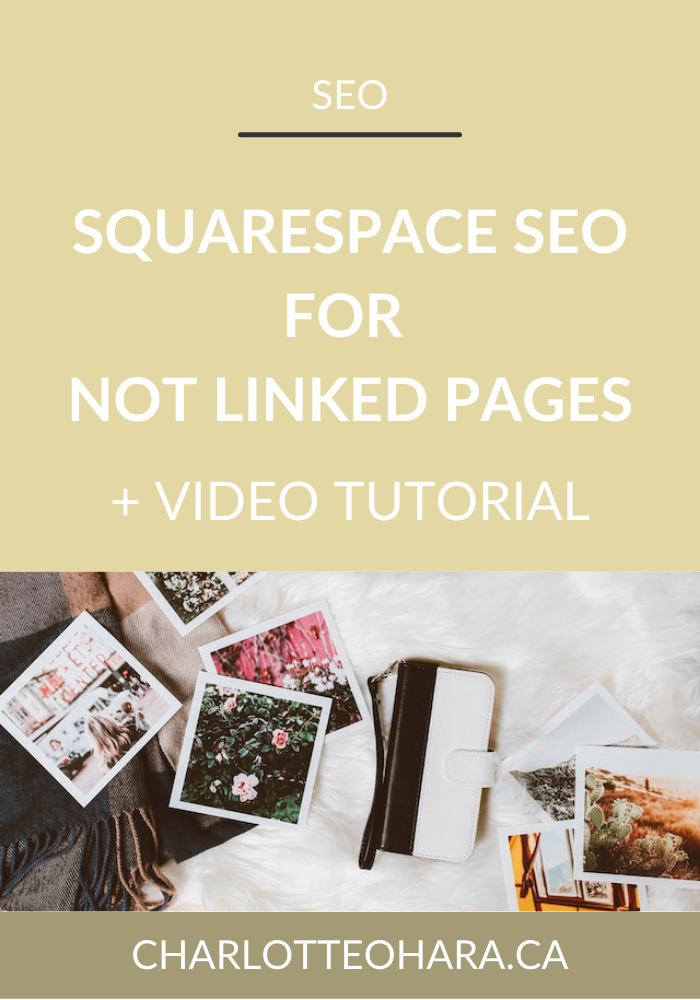The most important on-site factors for Squarespace SEO
Back at it again with another highly requested video tutorial to help you on your Squarespace SEO journey! 😘
Recently I took you back to the basics of Squarespace SEO with the post & video tutorial Squarespace 101: Beginner’s guide to the 3 most important website settings. We made sure that your website was set up for success right from the start, which is what you want whether you have a new website or one that’s been around for a while.
Once those beginner steps are taken care of, we are then ready to move onto other parts of Squarespace SEO. It’s truly a topic that has many moving parts and it’s no wonder why people find it so overwhelming! As a Squarespace SEO expert and leader in this super random little niche, it’s my job/pleasure to introduce you to things like on-site factors for Squarespace SEO and present it in a way that doesn’t make you want to gouge your eyes out LOL!
This is the kind of insider info that I share with my Squarespace SEO consulting clients and students in my online course, Top Squarespace SEO. But since I’m not one for secrets and truly want the best for anyone with a website, I’m giving you the summarized goods here - totally for free!
Oh, and I’ve even recorded a video tutorial so that you can follow along in real time, peep over my shoulder and see for yourself exactly how these on-site SEO factors play out on a Squarespace website #yourewelcome
Some of you might be totally new to Squarespace SEO and are looking for an introduction to this topic, someone to hold your hand and show you it’s not actually that scary. On the flip side, you might already be familiar with a few points on this list already but maybe you are looking for confirmation that you’re on the right track and haven’t missed anything important. No matter where you are in your Squarespace SEO journey, I know you’ll benefit from this info!
I’m sharing the most important on-site SEO ranking factors so that you can dominate the search results and grow your website & business by leaps and bounds.
Alright, let’s get to it - read the post and watch the video tutorial below to learn all about the most important on-site SEO factors for your Squarespace website!
Related:
SQUARESPACE SEO SERIES
I have so many tips to share on the subject that it would have been crazy to put it all in one article! There are many misconceptions about Squarespace SEO which is why I've dedicate so many posts to this topic. Enjoy!
Click to view all posts in the Squarespace SEO Series
Visit my Squarespace SEO page for lots more resources.
The most important on-site factors for Squarespace SEO
An optimized website means more 👀 and 💰
I’m going to start us off here with some tough love:
Well optimized websites get more traffic, which has a direct impact on how well your business does - through product sales, leads/bookings of your services, affiliate or advertising revenue, etc.
Without SEO, your ideal audience (which represents potential clients/customers) won’t find you through online searches. And without that traffic coming in from online search results, your website isn’t going to grow at the rate you want or hit the milestones you crave. This is why you might be missing out or not reaching your full potential - but don’t worry, change is possible and you can have the growth and results you desire!
Keep the following on-site SEO factors in mind and watch your website (and business!) grow by leaps and bounds. The ROI is 🔥
Understanding search intent for website content optimization
Related: Why search intent is the secret weapon of Squarespace SEO (+ video tutorial)
Before I introduce you to the most important on-site factors for SEO, I want to make sure that you understand ‘search intent’ first because it basically directs everything else. Because if you haven’t considered search intent, then you won’t be able to optimize website content effectively… meaning that all your hard work might be for nothing!
Search intent basically means that you understand what people (aka real humans) are looking for when they do an online search. AKA, what are they trying to find when they type a bunch of words into Google?
In many cases, it’s pretty obvious what people are looking for with their online search - for example, if someone simply wants an answer to a question.
But there are other types of online searches that a person could make, and the words that they use will indicate the intent.
For example, if someone types in ‘compare X and Y’ then they are probably looking to purchase one of two products - a decision is going to be made. Like, if someone types “compare Lululemon and Alo yoga pants”, then the person wants to buy yoga pants and they are considering those two brands.
Take it another step further: if someone types in ‘buy ABC’ then obviously they are ready to make a purchase. So when the online search is simply “buy Lululemon yoga pants” then the person is ready to SHOP!
The keywords someone uses in an online search will likely change depending on if they want to:
Find a particular website (navigational)
Get the answer to a question (informational)
Research information before making a purchase (investigational)
Make a purchase (transactional)
Google is going to look at factors such as low click-through rates or high bounce rates to see whether or not your content matches a user’s intent for a particular online search - and they will adjust your ranking according.
Google crawls and indexes every website and follows a ranking system that they use to decide what content to return in online searches - and how you rank compared to other comparable/related web content.
Obviously you want to be at the TOP of search results (i.e., on the first page) because Google is basically saying that those websites are the most relevant and high quality results related to a particular online search. And if you dominate the rankings for the kind of online searches that your target audience is making? That’s a first-class ticket on the gravy train to GROWTH.
This brings us to the connection between search intent and on-site factors to optimize content.
A well optimized website includes different types of content for a variety of online searches. This is particularly true if you have a business website (that sells your products, services, events or other types of offerings) because you must have different types of content to target lots of searches that people could make.
You MUST understand what people are looking for online in order to have the right kind of content on your website so that you can show up at the top of those particular rankings.
On-site SEO factors apply to different types of pages
The on-site factors that we cover below need to be applied to EVERY type of page on your website. This includes:
Web pages (regular & index pages)
Blog posts
Product pages
Gallery pages
Event pages
The principles of on-site SEO are universal so once you’ve got a solid understand of what’s involved, then you can confidently apply it to any page or content on your website.
Ok enough “intro” - it’s time for the goods!
On-site factors for Squarespace SEO
Titles
The title tag is one of the very first things Google looks at when determining what content is relevant to an online search, but they are also the first impression many people have of your page.
Title tags are HTML elements that specify to search engines what the title of a web page, blog post, product description etc is. Basically the title tag should clearly and accurately describe the page’s content in a way that’s concise for both search engines AND real humans. These title tags are displayed as clickable headlines on any search engine results page (SERPs) and you’ll also see them in the display tab of your browser. A good title can be the deciding factor in determining whether or not someone clicks on your link, even if you show up high in search results.
Google typically displays the first 50–60 characters of a title tag so if you want your title to display properly, that’s something to keep in mind.
Good titles contain keywords but they are never overstuffed or just variations of keywords/phrases. That’s a turn-off for real people doing online searches but also something that could get you into trouble with search engines like Google.
Every page on your website should have a unique title. Again, this is important for user experience but also in driving higher click-through rates when your page shows up in search results.
URL Structure
URLs identify the file structure on any given website and indicates how a browser should retrieve information about a resource. There are 3 main reasons why URLs matter for SEO:
Improved user experience - A well-crafted URL gives both humans and search engines an easy-to-understand indication of what the destination page will be about.
Rankings - Search engines consider URLs as a minor factor when determining ranking of a particular page’s relevance to a search query. Weight of the overall domain AND the keywords used in a URL can both act as ranking factors. That being said, just because you use keywords in a URLs, it doesn’t mean that your site’s search visibility automatically increases - it’s a factor but not a major one, ya dig?
Links - well-written URLs can serve as their own anchor text when copied and pasted as links.
When it comes to URLs, best practice is to keep them as simple, relevant, self-explanatory, and accurate as possible so that both humans and search engines can understand them - which is necessary if you want your web pages to rank well. Consider that someone might only see a URL - does that give them enough of a preview to understand what the page will be about and if it’s relevant to their online search? Readability is super important in URL structure so make sure that you use hyphens to separate words in your URLs.
A few more tips for URLs:
Use lowercase letters
Do not use underscores, spaces, or any other characters to separate words
Although URLs can include ID numbers and codes, stick to words that people can comprehend
Related: The real reason why URL redirects are so important for Squarespace SEO
Headers
When it comes to Squarespace websites, we are generally talking about Header 1 (H1), Header 2 (H2) and Header 3 (H3) tags. These HTML elements identify headings and subheadings within your content from other types of text (e.g., paragraph text). When search engines “read” each page on your website, they are looking at the headers to indicate what a particular section of content is about - it provides content and helps to establish hierarchy and importance.
Headers are SEO factors because they:
Make content easier for humans to read and find the information they are looking for
Give search engines context to the keyword-rich context
Generally speaking you only want to use the H1 ONCE on any page, but you can use H2 and H3 multiple times - especially important with longer content.
Images
Images are the icing on the cake and a non-negotiable if you want a page/post/product to rank well in search results. It should come as no surprise that images are important for the real people who are reading a particular page - it breaks up the text, helps to provide visual content or instructions, showcases the product, etc.
Additionally, however, images are part of the web content that search engines look at and consider. They see that an image has been included and then “read” the image alt text to see a description of the content. This is why it’s SO important to name your images correctly because it can seriously help you content rank higher - both in regular and image search results. There’s exactly zero value in uploading an image to your page/post if all it has is a file name without any context or keywords. Images are suuuuper important and I’ve covered them quite a bit already on the site so I’m just going to leave you with the links below so you can check out the blog posts/video tutorials. Don’t sleep on images, my friend, they can be a huge factor for higher rankings!
Related:
How to add and format images on a Squarespace website - video tutorial
How to get images on your Squarespace website to show up in Google image search results
Links
There are 3 types of links:
Inbound links
Outbound (external) links
Internal links
When it comes to on-site Squarespace SEO, however, our focus is on outbound and internal links (because those are the ones we can directly control).
Outbound links: anytime time you link away from your website to other valuable & relevant content/websites. This is super important because if we think back to our goal of creating the best, highest quality content on a particular subject then you will naturally find yourself linking out to other websites. Google considers this when evaluating SEO and the value of a page. Obviously you don’t want to go overboard by linking randomly to other websites - instead, keep your ideal audience in mind and provide them with links to additional content/resources/etc. This also helps to establish links between your website and other websites.
Internal links: linking to other pages of your website. This helps tie pages together for both Google and site visitors, making each page more valuable. If you have an authoritative page and link to another page on your site, that helps your visitors find the other page and also passes on some authority. This helps that second page boost its search engine ranking. Any time you create new content on your website, be sure to add in internal links so that all the different pages of your site can support each other and help guide visitors around to different pieces of content.
With Squarespace, you can link to pages, external sites, files, email addresses, phone numbers, or internal content in many areas of your site. More info and instructions can be found here.
Unique content is non-negotiable
If you’ve made it this far, it should come as no surprise that a well-optimized website that hits all the important on-site SEO factors is built around unique content.
This means that you aren’t just copying and pasting the same content in different places around your website (i.e., rehashing the same product/services descriptions word for word in a blog post). It’s totally fine to use a template or leverage small bits of content here and there, but you don’t want to have the exact same content repeated - not only is it redundant for the human reader, it’s also something that search engines will pick up on.
Additionally, you should avoid having repeated content on your website that exists elsewhere on the internet. The most common example I can think of for this would be if you have a guest post on another website - obviously, you don’t want to just submit a blog post that you’ve already written and have it appear identically on another website. Again, there’s nothing wrong with tweaking a blog post a little bit and having it re-published on another site so that you can reach a whole new audience on that platform, but just make sure that the content is UNIQUE.
Same thing if unique content about you appears on another website - for example, if you were interviewed by anther outlet. DON’T just copy and paste the same content over on your website and trick yourself into thinking that it’s original content. Because again, Google and other search engines are going to crawl and index BOTH websites and will notice that the exact same content is repeated and that won’t help you rank higher in searches.
Final Thoughts
So there you have it, I hope you’ve enjoyed this introduction to the most important on-site SEO factors for your Squarespace website.
There’s a lot to consider with Squarespace SEO and I totally undestand that it’s a daunting subject when you’re first starting out, which is why I’m thrilled to help you out with this tutorial!
Whether you’re just starting out with a brand new website and want to make sure that you’re setting it up correctly, or if you’ve had a site live for a while and now want to grow it to make more of an impact, SEO will get you where you want to go! From web pages to blog posts to product descriptions, these factors should be considered across your Squarespace website if you want best results.
Don’t be afraid to go back and make updates either - better late than never!
Now it's your turn to tell me, have you heard about on-site SEO factors before? Are any of these new to you? Have you ever considered the connection between search intent and SEO? What are you going to try out first?
Leave me your questions down in the comments below and I’ll do my best to answer them. As people are spending more time online than ever before, it’s SO important that your website shows up properly in search results so that you can reach your ideal audience online - but you can’t do this without SEO! If you follow my tutorial and get these three settings set up on your Squarespace website, you’ll have the foundations in place to start growing and seeing results.
If you want more SEO goodness, be sure to check out my Squarespace SEO page for all resources on the topic.
My signature online course, Top Squarespace SEO, will be opening for enrollment again soon - sign up for the TSS waiting list here!
You can also sign up for my newsletter (right here or below), where I often share Squarespace SEO tips, tricks and high-quality exclusive content. I send out emails to my list every Wednesday, mostly focused on Squarespace websites and SEO, and I can guarantee that you’ll find the newsletter topics interesting, entertaining and worth your time. #humblebrag
Finally, shameless plug: hit me up with any specific questions you have about Squarespace SEO and your website because I’m your girl. You can reach out to me directly if you’re interested in working together on your website and we can talk about whether or not you would be a good fit for my consulting and ongoing services. I can’t take on every request to do Squarespace SEO consulting but I do pick a few websites and businesses to work with every month and I’d love for you to be one of them.
You may also be interested in:
Top Squarespace SEO - online course details and enrollment
Squarespace SEO for Affiliate Marketing - masterclass













